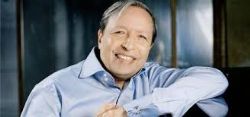|
Recital
ELEGANT VOCAL MASTERY AT ROSES SIGNATURE RECITAL
by Pamela Hicks Gailey
Sunday, February 25, 2024
Recital
DEMANDING SCHUMANN WORK IN MUSIC AT OAKMONT RECITAL
by Terry McNeill
Thursday, November 9, 2023
Recital
RARE RAVEL IN MENDO FESTIVAL'S PRESTON HALL
by Terry McNeill
Thursday, July 20, 2023
Recital
FRENCH FLAVOR IN RARE FOUR-HAND RECITAL
by Judy Walker
Sunday, January 15, 2023
Recital
ASSERTIVE PIANISM IN YAKUSHEV'S OCCIDENTAL RECITAL
by Terry McNeill
Sunday, November 13, 2022
Recital
HEROIC LIM PERFORMANCE AT STEINWAY SOCIETY RECITAL
by Abby Wasserman
Sunday, September 18, 2022
Recital
AGGRESSIVE PIANISM IN MYER'S MENDO FESTIVAL RECITAL
by Terry McNeill
Thursday, July 14, 2022
Recital
UNIQUE ELEGANCE IN GALBRAITH GUITAR RECITAL
by Gary Digman
Friday, April 29, 2022
Recital
ALLURING GLASS WORKS IN WEILL RECITAL
by Terry McNeill
Friday, March 25, 2022
Recital
FORGOTTEN BACH SHINES IN YARDEN'S OAKMONT RECITAL
by Terry McNeill
Thursday, March 10, 2022
|
 |
 Pianist Murray Perahia |
PERAHIA'S INTENSITY SHINES IN WEILL HALL RECITAL
by Terry McNeill
Saturday, March 7, 2015
Murray Perahia has built a long pianistic career based on performances of discernment, classical structure and impeccable taste. His playing always exudes a refinement and lapidary attention to musical detail. And so it was in his March 7 Weill Hall debut recital before an audience of 900, with a conventional program of balanced and celebrated works.
Opening the evening Bach’s 6th French Suite (BWV. 817) received a reading emphasizing careful dynamic control, fast tempos in the Courante and Bourrée, intriguing embellishments and much half pedal. In Weill piano concerts with a less-than-full house, fast tempos, diminished volume and legato playing can pose clarity difficulties. And Mr. Perahia’s Bach and the Beethoven “Les Adieux” Sonata that closed the first half, especially in Le Retour, displayed a lack of textural clarity in the fleet sections with large resonance.
This is not to say that the pianist played the Op. 81a Sonata routinely, a piece he has lived with for decades. The Andante Espressivo L’Absence had the requisite sprightly tempo, lovely tone colors and patrician phrasing, and surprisingly in the finale there were doubled left-hand bass chords and brusque sforzandos. The music always had intensity and prismatic tints that shone resplendidly.
New York Times critic Harold Schonberg described Mr. Perahia’s pianism, after honoring the note-perfect mastery and serious musicianship, as in many big works “overly polite.” If that observation was accurate, and I think it was, things have certainly changed, as in Franck’s Prelude, Choral and Finale that opened the second half. In each of the program’s works, save for Haydn’s fleet A-Flat Major Sonata, smudged notes popped up but never affected the music’s impetus or in the Franck the course of the big single melodic idea. The playing captured the piece’s Romantic mystical nature and the Bach references in the Fugue. There were unexpected inner voices and just a little ferocity in the Choral, the focal point of the 1884 piece, a specialty of the late Jorge Bolet.
Chopin’s B Minor Scherzo ended the program. Here Mr. Perahia used big dynamic contrasts to give variety to the many repeats (I have always thought the cut version more effective) and though he eschewed big sonority he seized the Scherzo’s restless momentum and histrionics. The fiery coda went off the tracks in the final tumultuous upward run but the audience rightly loved it and responded with a prolonged standing ovation.
Chopin’s F Major Nocturne from Op. 15 was the first encore, and the playing was curiously lacking in subtle rubatos and had monochromatic tone color. The tranquil cantilena and strong left hand in the turbulent middle section were admirable. Speed returned to buffet clarity in the last encore, Schumann’s Traumes Wirren from the Op. 12 Fantasiestücke. Since these “dreams” are skittish, finger velocity is a necessity, and Mr. Perahia provided it but without transparent control at the highest level of technique.
The pianist’s connection with Weill’s audience was formal and unassuming (minimal bows, austere facial expression) that in some ways reflected his cultivated and assured artistry.
|
